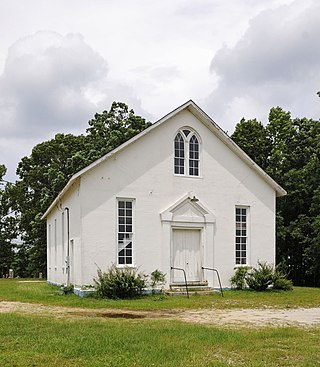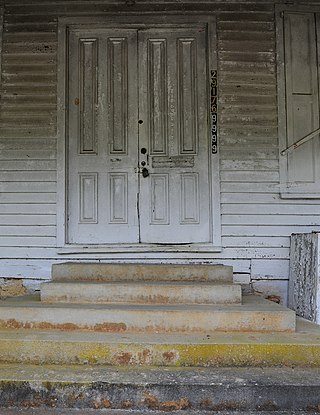
Fairfield County is a county located in the U.S. state of South Carolina. As of the 2020 census, its population was 20,948. Its county seat is Winnsboro.

Winnsboro is a town in Fairfield County, South Carolina, United States. The population was 3,550 at the 2010 census. The population was 3,215 at the 2020 census. A population decrease of approximately 9.5% for the same 10 year period. It is the county seat of Fairfield County. Winnsboro is part of the Columbia, South Carolina metropolitan Area. Winnsboro is a suburb of a Columbia, South Carolina.

Concord Presbyterian Church is a historic Presbyterian church located near Winnsboro, Fairfield County, South Carolina. It was built in 1818, and is a one-story, brick, gable-roofed building with a meeting house floor plan. It has a small, rectangular, gable-roofed rear extension and sits on a granite foundation. Also on the property is a cemetery with a cast-iron fence and gates.

Mount Olivet Presbyterian Church is a historic Presbyterian church located near Winnsboro, Fairfield County, South Carolina. It was built in 1869, and is a one-story, rectangular, front-gabled stuccoed brick building. The stucco is scored to resemble cut stone and the church sits on a granite foundation. The large cemetery northwest of the church contains several historically and artistically significant gravestones dating back to 1795 and is enclosed by a cast-iron fence.

New Hope A.R.P. Church and Session House is a historic Associate Reformed Presbyterian Church building and Session House located near Winnsboro, Fairfield County, South Carolina. They were built about 1886. The meeting house form church is a one-story, weatherboarded, frame church. It features a bracketed belfry with a bellcast roof. The session house is a 10 by 12 foot weatherboarded frame building with a gable roof.

Tocaland is a historic plantation house located on S.C. Route 344 near Winnsboro, Fairfield County, South Carolina. It was built about 1854, and is a 1+1⁄2-story, weatherboarded frame Greek revival style dwelling on a raised basement. The front facade features four 8-foot high stuccoed granite piers that support a pedimented front porch. The porch is supported by four paneled wooden pillars, pilasters, and has a plain balustrade.

Balwearie is a historic plantation house located near Winnsboro, Fairfield County, South Carolina. It is a 1+1⁄2-story, brick and frame residence with a gabled roof and cross-gabled front porch. The first story is of brick construction; half-story is sheathed in weatherboard. The front gable is supported by six paneled wooden posts. The house was constructed about 1822, but altered following an 1886 storm. A rear porch was converted into a kitchen in 1975.
Bob Lemmon House is a historic farmhouse located near Winnsboro, Fairfield County, South Carolina. It was built about 1850, and is a two-story, frame I-house. It has a gable roof, a single pile, central hall plan, and rear shed room additions. The façade features a two-tiered pedimented portico with four wooden Tuscan order columns. The property also includes a shed and a barn, both of frame construction sheathed in weatherboard.

Old Stone House is a historic home located near Winnsboro, Fairfield County, South Carolina. It was built in 1784, and is a two-story, side-gable roofed, stone building, with a double-pile floor plan and stone end chimneys. The façade has a central door with a massive stone lintel flanked by single four-over-four windows with stone lintels. It was built by Samuel Gladney and in 1870 it was purchased by the Lebanon Presbyterian Church for use as a parsonage.

The Oaks is a historic plantation house located near Winnsboro, Fairfield County, South Carolina in the Piedmont region. It was built in 1835 by Richard Hallum, and is a large, two-story, weatherboarded frame residence with a gable-end roof. The front façade features a central, two-tiered pedimented portico supported by four simple wooden columns. From 1856 the property was owned by John Montgomery Lemmon and his descendants. Considered a moderately wealthy planter, in 1860 he owned 19 slaves and his entire plantation was worth $10,000.

Rural Point, also known as Robertson House and Doty House, is a historic home and garden located at Winnsboro, Fairfield County, South Carolina. It was built in 1852, and is a 1+1⁄2-story, 12 bay, Greek Revival style frame dwelling over a high basement. The façade features a gable-roofed porch which is supported by four square columns. The property features a semi-formal garden said to have been designed by John Grimke Drayton, noted landscape architect of Magnolia Gardens in Charleston, South Carolina. Also on the property is a typical southern planter's office of white clapboard. It was built by William Ross Robertson, probate judge and commissioner of equity of Fairfield County who served in South Carolina House of Representatives and as a member of the Secession Convention.

Ketchin Building, also known as the Fairfield County Historical Museum, is a historic building located at Winnsboro, Fairfield County, South Carolina. It was built about 1830, and is a three-story, five bay, Federal style brick building with a hipped roof. Originally built as a dwelling by Richard Cathcart in 1830, it was sold in 1852 and was used as Catherine Stratton Ladd's Winnsboro Female Institute until closed by the American Civil War.

Dr. Walter Brice House and Office is a historic plantation house and office located near Winnsboro, Fairfield County, South Carolina. It was built about 1840, and is a two-story, weatherboarded frame, L-shaped Greek Revival style dwelling. It features a two-tiered, pedimented front verandah supported by four wooden pillars. The Dr. Walter Brice Office is a 10-foot-by-12-foot weatherboarded frame building with a metal gable roof. Dr. Walter Brice was a prominent Fairfield County planter and physician before the American Civil War.

Furman Institution Faculty Residence is a historic residential building located near Winnsboro, Fairfield County, South Carolina. It was built about 1837, and is a two-story, brick building with a hipped roof and end chimneys. It has a single story, hip roofed front porch and a kitchen extension. The building serves as a visible reminder of the early history of Furman University and its brief establishment in Fairfield County.

Shivar Springs Bottling Company Cisterns is a set of six historic cisterns located near Winnsboro, Fairfield County, South Carolina. They were built about 1900, and are a group of six cylindrical, stuccoed stone cisterns with concrete domes. The Shivar Springs Bottling Company was in operation from about 1900 to about 1950. At first the company produced only mineral water which was sold for medicinal purposes. Later both mineral water and soft drinks were produced from the spring water and shipped throughout the state.
Blair Mound is a historic archaeological site located near Winnsboro, Fairfield County, South Carolina. Blair Mound is an earthen mound structure in the form of a low, oval hummock. It measures approximately 75 by 50 yards and is just over 5 feet (1.5 m) high, with evidence of leveling for agricultural development.
McMeekin Rock Shelter is a historic archaeological site located near Winnsboro, Fairfield County, South Carolina. The McMeekin Rock Shelter is formed by a granite outcrop of the south bank of a small tributary drainage of Frees Creek. The overhang of the outcrop is roughly one meter above present ground surface and shelters about 10 square meters of surface area. It is believed that a number of short-term occupations occurred at the site from ca. A.D. 1200 to ca. A.D. 1400.

White Oak Historic District is a national historic district located near Winnsboro, Fairfield County, South Carolina. The district encompasses 12 contributing buildings in the rural community of White Oak. The buildings in the district were built between about 1876 and about 1925, and includes three large frame residences, a frame church with steeple, two frame store buildings, a cotton warehouse, and two vacant, wooded lots, some of which reflect Victorian stylistic influences. Notable buildings include the T. G. Patrick Store, McDowell's Store, White Oak Cotton Warehouse, Matthew Patrick House, T. G. Patrick House and outbuildings, and White Oak A.R.P. Church and Manse.

Winnsboro Historic District is a national historic district located at Winnsboro, Fairfield County, South Carolina. The district encompasses 33 contributing buildings and 1 contributing site in the county seat of Winnsboro. The district features a wide range of architectural styles, from early simple frame houses that reflect utilitarian aspects of the Scotch-Irish, the first principal settlers, to pronounced styles such as Federal and Greek Revival. Many residences are typical upcountry frame houses, built in an L-shape with long piazzas running across the front. Notable buildings include the Town Clock, Fairfield County Courthouse, Thespian Hall, Fairfield Country Club, Mt. Zion Elementary, the separately listed Ketchin Building, Beatty House, Wolfe House, Kirkpatrick House, Neil House, and Williford House / Town Hall. The Fairfield Country Club was built in 1822 under the supervision of Robert Mills.

Rockton and Rion Railroad Historic District is a national historic district located near Winnsboro, Fairfield County, South Carolina. The district encompasses 40 contributing buildings, 6 contributing structures, and 2 contributing objects associated with the quarrying, finishing, and transporting of Winnsboro blue granite. The district resources were built between about 1883 and about 1945.





















